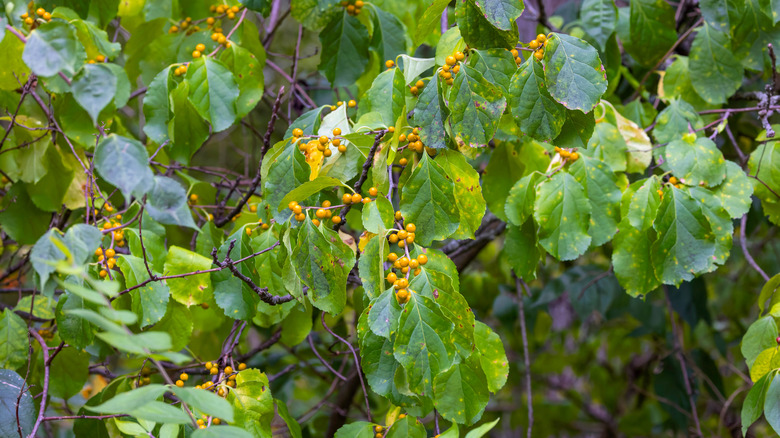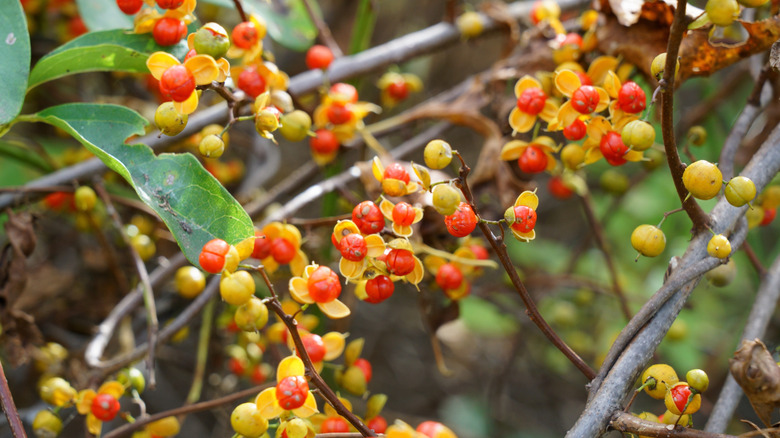How To Get Rid Of Fast-Growing Oriental Bittersweet If It's Taking Over Your Yard
Of the many different invasive vines that trouble American gardeners, Oriental bittersweet, also known as round leaf bittersweet (Celastrus orbiculatus), is one of the worst. Not only is it fast-growing, it wraps itself tightly around trees and structures. For some people, like myself, this vine can sometimes cause severe allergic reactions, like a painful rash (similar to poison ivy). I have to deal with Oriental bittersweet frequently as a professional gardener and have found there are two main methods for eradicating it: physical (cutting, trimming, or digging out the roots) and chemical (using herbicides or copper).
Oriental bittersweet is often difficult to get rid of, and it's hard to protect your yard and trees from this invasive vine once it has established itself. The vines can get very big and become enmeshed with various structures including chain link fences, utility poles, and electrical wires. In gardens, bittersweet vine can engulf shrubs and trees, eventually killing them and necessitating the costly removal of large trees. The best solution to this damage is prevention, but because this vine grows so quickly, many homeowners don't know they have a problem until it's already out of hand.
If you have bittersweet growing on your property, prepare for what may be a difficult battle. You may find it takes a year or more to get rid of it, as well as continue to do preventive maintenance. But allowing Oriental bittersweet to grow and spread can cause serious problems in the long run, so it's best to address it as soon as possible.
How to eradicate bittersweet
If your bittersweet vines are smaller in diameter than a nickel, cut back the stems and dig up the roots. The roots are bright orange and easy to spot. Dispose of all these plant materials in a trash bag, not in your compost heap or brush pile. For bigger stems, you can use a chemical herbicide. Natural substances like horticultural vinegar are worth a try, but you may need to use something stronger, like RoundUp.
Herbicide is most effective in early spring just as new growth is emerging. Cut the stem crosswise with a pruning saw. Wait a week for the roots to be stimulated by the cut — this will make the plant more vulnerable — then paint concentrated RoundUp across the surface. Repeat this every two weeks for two months. Eventually the vine and roots will die. Though you should think twice about using this popular weed killer, as RoundUp has numerous environmental and health hazards, follow the label directions to use it safely. As an organic gardener, I prefer not to use toxic herbicides, but this is the one plant I make an exception for. That said, I use RoundUp as sparingly as possible.
If you have a very large bittersweet vine, as big around as a tree, try the European method people use to kill old tree stumps (especially invasive trees): copper nails. Drive some copper nails into the cut stump, and over time, the copper causes a chemical reaction, instigating the stump to decompose. Try this in spring. It usually takes several months to work. Repeat the following spring if any new growth has emerged from the stump.
Safety precautions
Oriental bittersweet is considered invasive in a number of states and is continuing to spread to more areas. Because of its fast-growing nature, removing it can involve being exposed to lots of plant matter. Timing can be a factor; the plant's toxicity is stronger during the height of the growing season, so cutting it back or removing it is more safely done in early spring before new growth appears or just before winter when it has gone dormant. However, it is very important to observe safety precautions when dealing with this plant.
The oil that causes skin irritation can't be seen on skin and may remain on fabric for months. Wear long sleeves and protective gloves, and wash all tools and exposed clothing well after contact. I usually keep one pair of gloves separate from my other garden gloves and use them just for handling bittersweet. Wash all exposed skin (even if you think you didn't touch the plant) with Dawn dish soap and water, scrubbing well with a clean sponge. In my experience, this method is more effective than soaps meant to prevent and alleviate skin irritation from plants like poison ivy.
Don't put Oriental bittersweet into your compost or brush pile. This plant is notorious for re-rooting itself vigorously even after it's been cut. To keep bittersweet out of your yard and avoid having it increase in your area, dispose of it separately from other yard waste. Burning bittersweet is not recommended, as this can stimulate fuller growth. Once you've made the effort to remove bittersweet, keep an eye out for its return so you can address it quickly.


